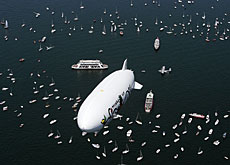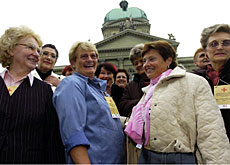2,000 ships mark post-war aid for children

A huge flotilla of ships on Lake Constance has been commemorating the assistance given by Switzerland to thousands of German children in the post-war years.
More than 2,000 vessels formed an 11-kilometre-long “floating bridge” across the lake from the Swiss town of Romanshorn to the German resort of Friedrichshafen on Sunday.
During the aftermath of the war thousands of malnourished and traumatised children from Germany were invited to Switzerland – which as a non-participant in the Second World War had maintained a relative affluence – for a daylong stay.
They were received by families who fed and looked after them before they were taken back by boat across the lake to Germany.
Many “Swiss Children”, as they were called, remember being given coffee and cake, and being sent back with such post-war rarities as chocolate, oranges and cocoa.
The commemoration to mark the 60th anniversary of the start of this initiative was organised by the German Swiss Children association, some of whose founding members made these trips to Switzerland. The association now helps underprivileged children.
Among the boats in the floating formation was the Swiss Thurgau passenger steamboat, which was used to take the German children over to Switzerland.
The boat, along with three other vessels, formed the Swiss cross at the centre of the floating bridge.
Acts of humanity
According to Gernot Erler, who represented the German foreign ministry at the event, around 44,000 German children benefited from Swiss aid in the post-war years. Switzerland also took in young people from Austria, the other war-affected Lake Constance border country.
In a speech, Erler praised the “practical acts of humanity and helpfulness from our neighbour”, which had helped to start dialogue between the two countries.
Sunday’s bridge was a sign of the current connection between the two countries, he added.
For her part, Renate Bruggmann, the cantonal parliament speaker for the lakeside Swiss canton of Thurgau, spoke of the aid being “the start of reconciliation” after the Second World War.
Speakers also pointed to the fact that the Swiss assistance, a largely church-run initiative, was not without controversy at the time. Many Swiss were still wary of their once-powerful German neighbour.
The Swiss Children Association’s vice president, Hildegard Nagler, said she hoped that the willingness to help children – as shown in the years after the war – would continue today.
“After what is probably the largest boat bridge in the world, we are still hoping for more bridging of the gaps for children in need,” Nagler said.
swissinfo with agencies
In 1946 and 1947 thousands of children from the lakeside area of Germany, and later the southwest, were invited to Switzerland for a day.
From 1972 onwards groups of Swiss and German individuals started to meet up to commemorate these events.
In 2000 around 80 original Swiss children took part in a reconstruction of their post-war trips to Switzerland, which was organized by a German and a Swiss newspaper.
In 2003 the Swiss Children Association was founded and a book on the subject by Hildegard Nagler was published.

In compliance with the JTI standards
More: SWI swissinfo.ch certified by the Journalism Trust Initiative

You can find an overview of ongoing debates with our journalists here . Please join us!
If you want to start a conversation about a topic raised in this article or want to report factual errors, email us at english@swissinfo.ch.